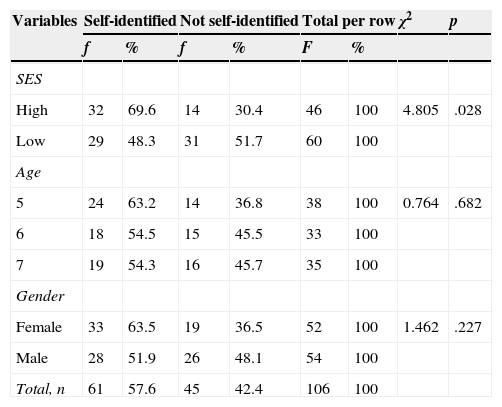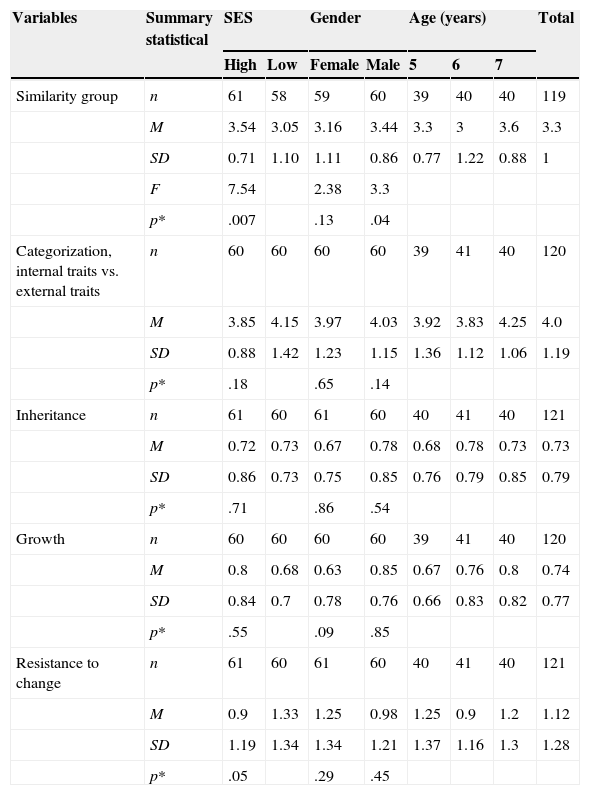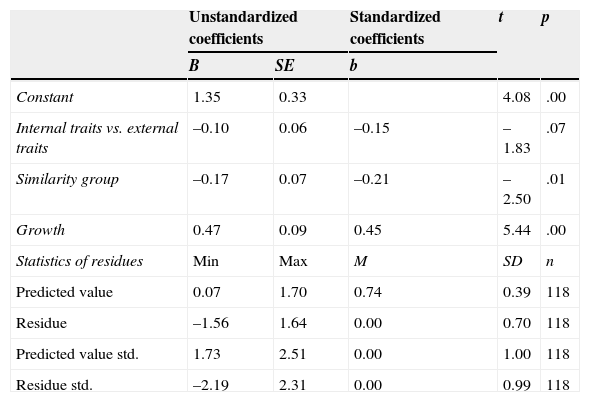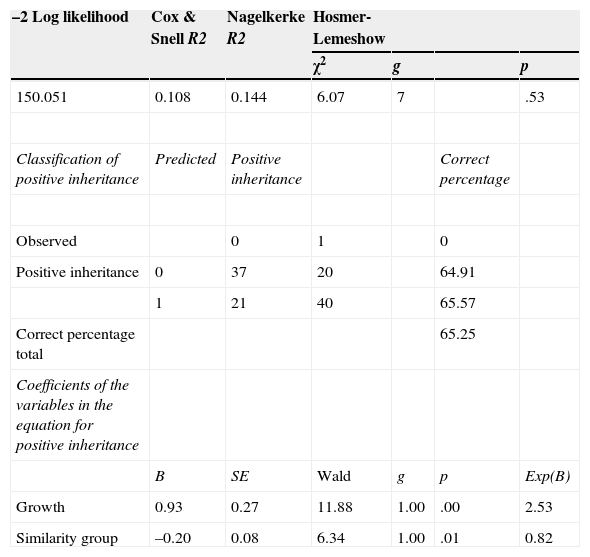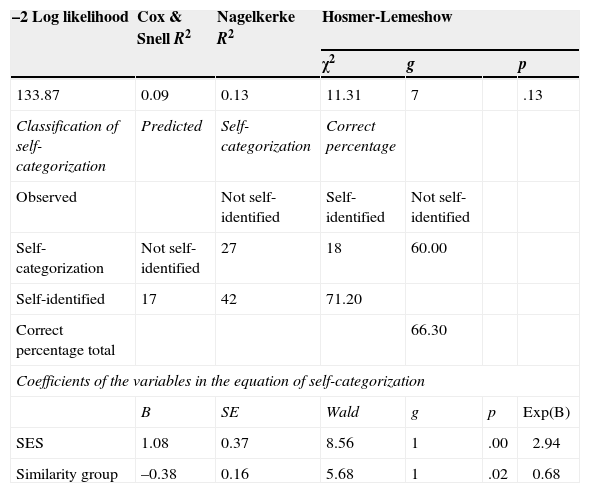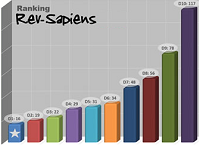The aim of this study was to determine whether the social categorization of poverty during childhood is based on essentialist beliefs. The study included 121 children, aged 5 to 7, from different socioeconomic backgrounds living in the city of Barranquilla, Colombia. The children stated that the nature of this social category is based on situations external to the individuals rather than essentialist reasons. No significant differences were found as regards age, gender or socioeconomic status (SES), except in the capacity of the respondents to self-categorize their social status. Children who find fewer differences between members and non-members of a given category tend to err in their self-categorization, which is important for the prevention of social exclusion.
El objetivo de este estudio es determinar si la categorización social sobre la pobreza en la infancia está basada en creencias esencialistas. El estudio incluyó a 121 niños de entre 5 y 7 años de edad, de distinto nivel socioeconómico y residentes en la ciudad de Barranquilla, Colombia. Los niños plantearon que la naturaleza de esta categoría social está basada en situaciones externas a los individuos, en lugar de atribuirla a razones de tipo esencialista. No se encontraron diferencias estadísticamente significativas relacionadas con la edad, el sexo o el nivel socioeconómico, a excepción de la capacidad de autocategorizarse de acuerdo con su estatus social. Los niños que encuentran menos diferencias entre los miembros de la categoría y quienes no lo son tienden a equivocarse en la autocategorización, lo cual resulta importante para la prevención de la exclusión social.
Categorization helps simplify the social environment, thus allowing us to focus our attention selectively and to make predictions based on general expectations (Erdley & Dweck, 1993) so that we can make decisions which are more likely to occur. Bar-Tal (1996) has studied how stereotypes and social categorization occur, suggesting that these are representations generalized to a group of people, objects or events as if they were all of a kind. That is, the categories capture the idea that objects, events or people are alike in important ways and therefore can be grouped and treated in a similar fashion, whilst being differentiated from other objects, events or people that do not belong in this group (Bar-Tal, 1996).
Certain social groups are considered categories because people routinely categorize others into social groups and therefore into categories (Bar-Tal, 1996). The characteristics attributed to categories of people are stereotypes, which involve learning the group category and then learning the attributes that characterize a particular group of people. The attitudes and behavioral intentions towards groups are formed in this learning process. According to Bar-Tal (1996), this process begins in early childhood.
It should be noted that categorizations and inferences that we form are not always accurate. If features are considered to be rigid rather than flexible categories, our judgments may become more rigid, and features eventually limit —rather than facilitate— the effective use of social information (Erdley & Dweck, 1993). Thus, categorization can lead to negative attitudes and maladaptive forms of relationships that are generally rooted in our cognitive structure. They occur even in the face of serious social problems such as prejudice, social exclusion and discrimination, which are based on stereotypes of social groups (Philip, Mahalingam & Sellers, 2010). Persistence of stereotypes depends on the relationship between people, their social environment and the hypotheses they form about the views of people who are important to them (Carnaghi & Yzerbyt, 2007; Philip, et al., 2010).
According to Medin (1989, 2005), we categorize on the basis of guiding theories, such that we are more likely to form a category if it has an explanatory relationship to the objects within it, rather than when we group attributes from a list (Del Río, 2008).
Social behavior has often been treated as belonging to the field of consciousness (not always reflexive), there is now considerable evidence that social behavior often operates in an implicit or unconscious way as a result of past experiences. Thus, attitudes, self-esteem, and stereotypes have important implicit modes in its operation (Greenwald & Banaji, 1995).
Psychological essentialism is defined as the tendency to believe that objects, people or groups have an underlying essence that makes them what they are (Medin, 1989). According to Prentice and Miller (2007), it is a common way to categorize representations, although it has powerful psychosocial consequences. “Essence” can be defined as the set of biological, cultural or social characteristics that underlie a social group and form a stable quality shared by all members of a group (Estrada, Oyarzún & Yzerbyt, 2007). One of the psychosocial consequences of essentialist thinking is the belief that human attributes are immutable and particularly likely to endorse and explain social stereotypes with reference to innate factors (Bastian & Haslam, 2006).
Essentialism in childhood cognitionStudies of cognitive development indicated that children categorize their experiences according to the superficial appearance of objects, gradually developing higher cognitive abilities such that they can categorize according to deeper elements (Piaget & Inhelder, 1975). Piaget and Inhelder (1975) say that an important aspect of intellectual development is the understanding of conservation, by which elements such as volume, mass, and number remain unchanged despite superficial variations in shape or appearance. Rholes and Ruble (1984) suggest that certain invariants in children's thinking are quantitative (volume), while others are qualitative (gender constancy) (Rholes & Ruble, 1984; Taylor, Rhodes & Gelman, 2009).
Rholes and Ruble (1984) suggest that children under the age of 8 rarely use stable personal constructs (dispositional) in their descriptions of others, tending to describe others in terms of superficial qualities such as appearance, possessions and place of residence. From the standpoint of attribution, this implies that younger children do not conceptualize the behavior of others in terms of internal factors.
Recent studies (Del Río, 2008; Del Río & Strasser, 2007; Diesendruck & HaLevi, 2006; Gelman, 2004) present evidence indicating that, contrary to what had been believed, from an early age, children attach to underlying traits when they form categories. Children are guided more by entities’ essences than by their perceived similarities (Del Río & Strasser, 2007).
Thus, we can say that essentialism constitutes “a persistent bias of reasoning that affects the development of the categorization in a profound way, is integrated into our conceptual system, and emerges at an early age in different cultural contexts” (Del Río & Strasser, 2007, p. 140). Del Río and Strasser (2007) found that children attribute poverty to internal traits and believe that certain properties within this category are hereditary. Their findings indicate that children utilize the poverty category to make inferences about people suffering from this state such that the growth and superficial changes that impoverished people experience in their lifetime do not change their membership in this category.
Essentialism is a theory which is reinforced over time, its implications refer us back to the dilemma between the biological (represented by the innate tendency to essentialize) and the environmental (represented by beliefs that favor social categorization). The importance of finding common ground between the two perspectives is fundamental if one hopes to prevent exclusion and inequality as result of social categorizations.
This paper undertook to determine the nature of the beliefs that underlie the social category of poverty among children aged 5 to 7 from different socioeconomic backgrounds. We tested the hypothesis that the social categorization of poverty occurs in conjunction with an innate tendency towards essentialism and the beliefs which are promoted within one's own culture.
MethodsParticipantsThe children were contacted through their educational institutions. We obtained authorization from their families. The study was developed with two groups whose members were intentionally selected. The first group consisted of 12 children and the second group consisted of 121. Both groups were approximately equal according to age (between the ages of 4 and 7), gender and SES (low SES and high SES).
The children were contacted at two schools: a public school located in a socioeconomically vulnerable neighborhood and a private school whose students come from households with a higher SES, according to information provided by the institution.
Materials and proceduresQualitative stage. Conducted to obtain information about the children's beliefs regarding the origins of poverty. It allowed us to study the children's lexicon and adapt the instruments that were applied in the second stage. Two interviewers conducted an ice-breaker activity to make the participants comfortable with the process. This stage included the 12 children from the first group. They were interviewed individually at their school. The children had to draw pictures to answer “What are poor people like? Why are they poor? What makes them poor?”.
Quantitative stage. The group of 121 children responded to the Self-Categorization Test, the Group Similarity Test, the Categorization Test According to Internal vs. External Traits, the Inheritance and Growth Test and the Test of Resistance to Change, designed by Del Río (2008) to measure childhood essentialism regarding poverty. We performed a descriptive statistical summary and a logistic regression model to understand the relationship between the variables and to establish a predictive model.
Instruments. Adapted from Del Rio (2008):
- •
Self-categorization. This instrument measures whether the children are able to categorize themselves according to their SES of origin.
- •
Group similarity. Aims to study the perceptions of group variability among poor people. The test determines whether people belonging to an impoverished group are judged as similar to or different from those outside the group (Del Río, 2008).
- •
Categorization according to internal traits vs. external traits. Evaluates the inductive power of the social category of poverty, measuring whether children give priority to the category rather than to the superficial information they have about the people.
- •
Inheritance and growth. These subtests explore children's beliefs about the heritability of poverty-category membership and its persistence despite the members’ growth. The tasks were designed by Del Rio (2008) based on those used by Hirschfeld (1995) in relation to the racial category.
- •
Resistance to change. This instrument inquires into the persistence of poverty-category membership, despite the superficial changes occurring in the members’ lives. Del Río (2008) based its construction on tasks designed by Keil (1996).
In the responses given by the 12 children participating in the interview, there was no appeal to essentialist causes for belonging to the poverty category. In the analysis, eleven categories emerged inductively from the children's responses.
In general terms, when the children were asked about the nature of poverty (“What are poor people like?”), they appealed in particular to the lack of material goods, to the behaviors or activities characteristic of the “poor”, and a situation of neglect and lack of social support. They also suggested, although to a lesser extent, ideas about the presence of external agents associated with poverty, beliefs about health and living conditions, the lack of purchasing power that limits poor individuals’ ability to secure work or food, and ideas of predestination and race associated with poverty.
Material shortages. This category contains the largest number of the children's poverty-related beliefs. In general, children of high SES expressed that poor are the people who do not have food to eat, for example: “[They are] those who have no food”; low-SES children reported that the poor do have food, but that it is insufficient: “They are making their food but have little rice.” Other units of analysis were associated with lack of clothing lack of money, home, and material goods. Certain ideas were associated with lack of education, but these varied depending on the participants socioeconomic status. Among the high-SES children, it was observed that “[the poor] do not even have a school to study at.” Low-SES children suggested that the lack of money restricts access to education, such that the poor “do not study because their mother has no money.” Finally, the idea that the poor lack transportation was exclusively identified by high-SES children: “They get to school by walking.”
Activities and/or behaviors. Children of low SES attributed more activities and behaviors to poor people than the children of high SES. The units of analysis depicted both socially acceptable and unacceptable behaviors: “[A poor person] always goes to school … [and] does homework”; “they do not take care of the planet, they just throw [trash] anywhere and they are looking for more trash because they broke it.”
Lack of social support. We discovered phrases such as “[the poor] do not have parents.” Within the units of analysis, it was found that high-SES children associate the family with food: “and [they] do not have moms to make breakfast.” Meanwhile, the children of low SES associated family with the lack of money: “[they are poor] because the mother does not have money.” The high-SES children presented ideas such as “They have no nanny or someone who takes care of them.”
Agents. It represents responses linking external agents to the situation of poverty. Children of low SES demonstrated a greater adherence to this belief than children of high SES. One of the ideas associated with this category is charity: “they invite them to eat … give them water.” However, intentional harm was mentioned more frequently: “they have nothing because they are thrown out [by] the bad people.” They also discussed abuse and macrosocial violence as causes of poverty: “the house is destroyed… a bomb exploded.”
Sanitary conditions. The respondents who mentioned it believed that the poor live in unsanitary environmental conditions or are sick. The first idea that the participants associated with sanitary conditions was eating, and it was found only among high-SES children: “they drink water that is dirty.” We found that among the high-SES children, poverty was associated with a mental disorder: “they are crazy.”
Purchasing power. It refers to the lack of poor people's purchasing power to work and buy food. The children claimed that the poor “have no money to buy food.” They also associated employment with purchasing power: “they do not work because they have no money to buy a job.”
Mood. In this category, the children attributed to the poor psychological characteristics resulting from the lack of family, food or money. The first idea that the children associated with poverty was sadness due to loneliness, and this idea was identified by low-SES children: “[s/he is poor] because s/he is sad… [and] alone.” They also associated sadness with the lack of work: “it is sad because he cannot look for work.”
Fate/luck. It was found only among children of low SES and suggests that people are poor because fate wanted it that way: “God did not give them things.”
Work. The children argued that people are poor because they do not have jobs or are poorly paid. The category was identified only among low-SES children. It was associated with scarcity: “[the poor person] remains in the house because he has no job.” Another idea identified with work was sustenance: “They work for food.”
Race. It is argued that the poor belong to a specific race. This category was found only among children of high SES: “[the poor] are brown-skinned… black boys.”
Results of the quantitative phaseSelf-categorization. Of the 106 children who self-categorized, 58% identified with the SES of origin, while 42% did not. At the intragroup level, a chi-square test showed that there are significant statistical differences (p = .028) in relation to the participants’ SES, such that the high-SES children are more likely to correctly self-categorize (70%) than children of low SES (48%). No statistically significant differences according to age or gender were found for self-categorization (Table 1).
Self-categorization according to SES, age and gender.
| Variables | Self-identified | Not self-identified | Total per row | χ2 | p | |||
|---|---|---|---|---|---|---|---|---|
| f | % | f | % | F | % | |||
| SES | ||||||||
| High | 32 | 69.6 | 14 | 30.4 | 46 | 100 | 4.805 | .028 |
| Low | 29 | 48.3 | 31 | 51.7 | 60 | 100 | ||
| Age | ||||||||
| 5 | 24 | 63.2 | 14 | 36.8 | 38 | 100 | 0.764 | .682 |
| 6 | 18 | 54.5 | 15 | 45.5 | 33 | 100 | ||
| 7 | 19 | 54.3 | 16 | 45.7 | 35 | 100 | ||
| Gender | ||||||||
| Female | 33 | 63.5 | 19 | 36.5 | 52 | 100 | 1.462 | .227 |
| Male | 28 | 51.9 | 26 | 48.1 | 54 | 100 | ||
| Total, n | 61 | 57.6 | 45 | 42.4 | 106 | 100 | ||
SES: socio-economic status.
Group similarity. The group mean for this variable was 3.3 ± 1 (n = 119). However, the low-SES children had a mean of 3.05, while those of high SES had a mean of 3.54, a significant difference between the groups (F = 7.54; p = .007). There was a trend away from random responses among the high-SES children, indicating that they were inclined to perceive greater similarities between people, regardless of their socioeconomic status. Regarding responses according to age, we found statistically significant differences between the groups (f = 3.3; p = .04). It follows that the older children showed a greater tendency to perceive similarities among people rather than to discriminate against them because of their socioeconomic status. There were no significant differences associated with gender (Table 2).
Essentialist thinking characteristics according to SES, age and gender.
| Variables | Summary statistical | SES | Gender | Age (years) | Total | ||||
|---|---|---|---|---|---|---|---|---|---|
| High | Low | Female | Male | 5 | 6 | 7 | |||
| Similarity group | n | 61 | 58 | 59 | 60 | 39 | 40 | 40 | 119 |
| M | 3.54 | 3.05 | 3.16 | 3.44 | 3.3 | 3 | 3.6 | 3.3 | |
| SD | 0.71 | 1.10 | 1.11 | 0.86 | 0.77 | 1.22 | 0.88 | 1 | |
| F | 7.54 | 2.38 | 3.3 | ||||||
| p* | .007 | .13 | .04 | ||||||
| Categorization, internal traits vs. external traits | n | 60 | 60 | 60 | 60 | 39 | 41 | 40 | 120 |
| M | 3.85 | 4.15 | 3.97 | 4.03 | 3.92 | 3.83 | 4.25 | 4.0 | |
| SD | 0.88 | 1.42 | 1.23 | 1.15 | 1.36 | 1.12 | 1.06 | 1.19 | |
| p* | .18 | .65 | .14 | ||||||
| Inheritance | n | 61 | 60 | 61 | 60 | 40 | 41 | 40 | 121 |
| M | 0.72 | 0.73 | 0.67 | 0.78 | 0.68 | 0.78 | 0.73 | 0.73 | |
| SD | 0.86 | 0.73 | 0.75 | 0.85 | 0.76 | 0.79 | 0.85 | 0.79 | |
| p* | .71 | .86 | .54 | ||||||
| Growth | n | 60 | 60 | 60 | 60 | 39 | 41 | 40 | 120 |
| M | 0.8 | 0.68 | 0.63 | 0.85 | 0.67 | 0.76 | 0.8 | 0.74 | |
| SD | 0.84 | 0.7 | 0.78 | 0.76 | 0.66 | 0.83 | 0.82 | 0.77 | |
| p* | .55 | .09 | .85 | ||||||
| Resistance to change | n | 61 | 60 | 61 | 60 | 40 | 41 | 40 | 121 |
| M | 0.9 | 1.33 | 1.25 | 0.98 | 1.25 | 0.9 | 1.2 | 1.12 | |
| SD | 1.19 | 1.34 | 1.34 | 1.21 | 1.37 | 1.16 | 1.3 | 1.28 | |
| p* | .05 | .29 | .45 | ||||||
SES: socio-economic status.
*Kruskal-Wallis test.
Categorization according to internal traits vs. external traits. Overall, the children's mean score was 4 ± 1.19 (n = 120), as expected for random answers. This finding suggests that there was not a marked tendency to categorize people according to their external or internal traits for membership in this category. There were no significant differences according to socioeconomic status, gender, or age (Table 2).
Inheritance and growth. For the inheritance subtest, the children's average score was 0.73 ± 0.79 (n = 121), and for growth, the average score was 0.74 ± 0.77 (n = 120). This finding indicates that there was a tendency to give random answers. There were no significant differences between groups according to SES, age, or gender for any of the variables (Table 2).
Resistance to change. We found an average score of 1.1 ± 1.3 (n = 121), indicating that children showed a tendency to exclude people with superficial and transient changes from the poverty category. No significant differences were found for the variable of “resistance to change” according to participants’ SES, gender or age (Table 2).
Analytical relationship model amongst variablesThe dynamics between variables were analyzed with a predictive model based on linear regression to predict the value of the hereditary and self-categorization variable (R = .48) as a function of the external characteristics, group similarity and growth. These variables were considered significant, while applying the model allowed for the dismissal of insignificant variables.
In the case of the hereditary variable, the model revealed that in 52% of the statistics, no dependency between the variables was observed. For the remaining 48%, in accordance with the weighting factors obtained from the model and given the value of the constant (B = 1.35), the variable inheritance should always be near to and above 1 (constant = 1.35). This finding indicates that the model correlates better to those statistics where the value of the inheritance variable is greater. The children who dismissed the heritability of poverty were those who demonstrated high values for the variable “external characteristics” (B = –0.10), “group similarity” (B = –0.17), or for both values. The variable “growth” positively added (B = 0.47) to the belief of poverty as being hereditary. The mean score of the residuals was zero (Table 3).
Variable linear regression coefficients for inheritance.
| Unstandardized coefficients | Standardized coefficients | t | p | ||
|---|---|---|---|---|---|
| B | SE | b | |||
| Constant | 1.35 | 0.33 | 4.08 | .00 | |
| Internal traits vs. external traits | –0.10 | 0.06 | –0.15 | –1.83 | .07 |
| Similarity group | –0.17 | 0.07 | –0.21 | –2.50 | .01 |
| Growth | 0.47 | 0.09 | 0.45 | 5.44 | .00 |
| Statistics of residues | Min | Max | M | SD | n |
| Predicted value | 0.07 | 1.70 | 0.74 | 0.39 | 118 |
| Residue | –1.56 | 1.64 | 0.00 | 0.70 | 118 |
| Predicted value std. | 1.73 | 2.51 | 0.00 | 1.00 | 118 |
| Residue std. | –2.19 | 2.31 | 0.00 | 0.99 | 118 |
The earlier model was complemented by the answers from those who in some way considered poverty to be inheritable (their score for “inheritance” was $ 1). A modified variable was designed for “positive inheritance,” above which we used a model of logistical regression with positive inheritance allocation for those whose probability was greater than .5. The best classificatory model was obtained using the variables of “growth” and “group similarity.” One hundred eighteen cases were included in the analysis. The Horner and Lemeshow test revealed a high significance. The earlier model has levels of sensitivity and specificity above 65%. The “growth” variable was identified to positively support the belief in the inheritability of poverty (B = 0.93), while the variable for “group similarity” influenced respondents toward believing the opposite (B = –0.20).
Logistic model for positive inheritance.
| –2 Log likelihood | Cox & Snell R2 | Nagelkerke R2 | Hosmer-Lemeshow | |||
|---|---|---|---|---|---|---|
| χ2 | g | p | ||||
| 150.051 | 0.108 | 0.144 | 6.07 | 7 | .53 | |
| Classification of positive inheritance | Predicted | Positive inheritance | Correct percentage | |||
| Observed | 0 | 1 | 0 | |||
| Positive inheritance | 0 | 37 | 20 | 64.91 | ||
| 1 | 21 | 40 | 65.57 | |||
| Correct percentage total | 65.25 | |||||
| Coefficients of the variables in the equation for positive inheritance | ||||||
| B | SE | Wald | g | p | Exp(B) | |
| Growth | 0.93 | 0.27 | 11.88 | 1.00 | .00 | 2.53 |
| Similarity group | –0.20 | 0.08 | 6.34 | 1.00 | .01 | 0.82 |
The exploratory model for self-categorization corresponds to a logistical binary regression, where the best model obtained in terms of classification, with all of its explanatory significant variables (p < .05), expresses self-categorization as an explanatory variable associated with SES and the “group similarity” variable (Table 5).
Logistic model of self-categorization.
| –2 Log likelihood | Cox & Snell R2 | Nagelkerke R2 | Hosmer-Lemeshow | |||
|---|---|---|---|---|---|---|
| χ2 | g | p | ||||
| 133.87 | 0.09 | 0.13 | 11.31 | 7 | .13 | |
| Classification of self-categorization | Predicted | Self-categorization | Correct percentage | |||
| Observed | Not self-identified | Self-identified | Not self-identified | |||
| Self-categorization | Not self-identified | 27 | 18 | 60.00 | ||
| Self-identified | 17 | 42 | 71.20 | |||
| Correct percentage total | 66.30 | |||||
| Coefficients of the variables in the equation of self-categorization | ||||||
| B | SE | Wald | g | p | Exp(B) | |
| SES | 1.08 | 0.37 | 8.56 | 1 | .00 | 2.94 |
| Similarity group | –0.38 | 0.16 | 5.68 | 1 | .02 | 0.68 |
One hundred and four cases were studied in this analysis, due to the fact that not all children provided their responses. Nevertheless, the predictive capacity with a cutoff point for correct self-categorization is at the level of 0.54, and the specificity (60%) and sensitivity (71.2%) is high. According to the findings, when the SES was high (B = 1.08), the children demonstrated a higher probability of correct self-categorization by 2.94 times. When children assigned a higher value to the “group similarity” variable (B = –0.38), the probability of incorrect self-categorization increased (Table 5).
DiscussionThis paper undertook to determine whether the nature of the beliefs that underlie the social category of poverty, in children from 5 to 7 years of age from different socioeconomic levels, is of an essentialist type. To achieve this, we tested a hypothesis whereunder the social categorization of “poverty” is produced in conjunction with the innate tendency toward essentialism and the beliefs that are promoted in the culture in which one is immersed. In general terms, it can be concluded that no evidence of essentialist thought is found among the participants as a basis for the social categorization of poverty. The results suggest that children prioritize external information about poor individuals to describe the causes of membership in the category. This finding manifests itself in the tendency for the respondents to mention the lack of material goods and social support as the nature of poverty and likewise to accept that transitory changes in the lives of these people may exclude them from the poverty category.
Similar results were identified by Chafel and Neitzel (2005) in a study with children from different SES, different ethnic origins and from urban and rural contexts. They found that a significant number of children are inclined to think that the origins of poverty are rooted in forces external to the individuals. The respondents associated the nature of poverty with situations such as the lack of nutrition, clothing, or a protective figure.
The findings of the above study as well as this study highlight the weight given to childhood cognition in explaining social phenomena based on external characteristics and physical stimuli. This emphasis can be explained according to Piagetian theories, given that the beliefs expressed by children identify ways of understanding the social world according to the movement from pre-operational thinking to concrete thinking. In of pre-operational thinking stage (approximately between 2 and 7 years of age), the child develops the capacity to think symbolically and to carry out operations in a logical way in one direction (Woolfolk, 2006). Nevertheless, it is important to note that in this study the youngest children also understand the lack of social support, the presence of agents which affect the lives of the poor, and the emotional states which are a product of these shortages, despite the fact that the Piagetian theory suggests that —at this age— it is difficult for one child to consider the perspective of another.
In this respect, Leahy (1981) suggests that the central category of the description of people is composed of deduced psychological characteristics such as traits or thoughts, which are fundamental elements in the process of group categorization. The possibility of identifying common characteristics such as grouping criteria is a characteristic of concrete thought (between the approximate ages of 7 and 11 years), which allows children the possibility of developing social categories such as poverty. Chafel (1997) has found that even children of preschool age, as in this study, are conscious of the inequalities present in society. Such an understanding may facilitate their later creation of categories such as poverty.
Bar-Tal (1996) affirms that from a very young age, children acquire concepts about social groups, although they have only a limited repertoire with regard to the significant groups, which they frequently find in their own social environment. Since Colombia is a country wherein over 50% of the population lives in socioeconomically vulnerable conditions, it is understandable that the children partaking in this study clearly identify the situation of poverty as a social category.
With regard to older children, this study finds that their ideas about poverty are more elaborated. Their descriptions of the conduct and activities carried out by poor people are more detailed.
Just as older children in this study demonstrated greater complexity in the category of poverty, the study by Pitner and Astor (2008) also found that older children had more elaborate ideas about impoverished environments. The children suggested that deteriorated places in and of themselves are not as dangerous as when people are found in them. As they grow, however, they assume the stereotypes promoted by others regarding human groups with greater arguments and justifications, which depend on very particular factors: the beliefs presented by the family and other socialization agents, the frequency and variety of their direct or indirect contact (through the media) with cultural stereotypes, and the intensity (level of confidence in the stereotype) and extension (grade of consensus) of their belief in the stereotype (Bat-Tal, 1996).
Another element that is emphasized in this study refers to the differences in self-categorization according to the children's socioeconomic level. Benett and Sani (2004) affirm that the study of the social self in infancy constitutes the basis of what will in adulthood mobilize forms of social perception and attitudes toward distinct groups. Brewer and Gardner (1996) describe the self-concept as the conjunction of the sense that one is different from others and at the same time the sense that one has something in common with others. Once the personal self is perceived to be part of a community, it will be influenced by stereotypes, norms and emotional experiences that one shares with the group (Turner, 1982) and sociocultural environment (Turner, 1977).
It is possible to argue that children of high SES who demonstrate greater identification with their status of origin may have had experiences that allowed them to identify themselves as part of their group and to distinguish themselves from those who do not conform to the group's characteristics. However, children of low SES, who contemplate this reality daily, make descriptions that tend to be negative and perhaps serve as a way to protect the respondent's self.
Additionally, this study finds that children who incorrectly self-categorize tend to find greater group similarities between people despite economic differences. This result may indicate that the more contact there is between populations of distinct socioeconomic levels, the weaker self-categorization and the categorization of others is based on this criterion. It may serve as a means to minimize inter-group differences and thus diminish stereotypes and prejudices.
It is important to emphasize here that the category of poverty developed by children is influenced by the form in which they perceive and value the other. Children's identification of emotional characteristics, lack of social support, and perception of similarity between poor people with those who are not may be a result of the children's empathetic attitude toward members of the category.
With regard to the condition of inheritance and the persistence of poverty despite people's growth, if results truly indicate that children have the tendency to give random answers, those who presented beliefs about inheritance were also inclined to consider the immutability of the category despite a person's growth throughout life. Nevertheless, it is necessary to mention that the use of a physical context in the test as an observable trait could be associated with biological characteristics, increasing the probability of the children perceiving them to be inherited. Therefore, the variables of inheritance and growth may be interrelated as functions of physical and biological traits rather than as essentialist evidence of the social category.
The results leave open the possibility of continuing to investigate the subject. They also provide hope for the possibility of diminishing the impact of social exclusion and prejudice in the relational dynamic of our societies. The evidence of decreasing bias in intragroup-intergroup thought in terms of social categorization and self-categorization, along with the perception of similarity between people beyond their socioeconomic differences, leads one to hypothesize that early childhood contact and friendly exchange with people from diverse social origins will augment the processes of inclusion and accessibility for all members of society. Additionally, this study's findings regarding young children's ability to identify with others’ perspectives and to attribute emotions to members of another category merit further investigation, as they contradict existing theories of early cognitive development.
With regard to the limitations of this study, an attempt was made to include children from 4 years of age. However, the open interviews in the first phase found that children of this age had difficulty in comprehending the instruments. We suggest continuing to carry out investigations that allow such techniques to be refined, given the difficulty of accessing the beliefs of younger children. This limitation implies, in addition, the evaluation of existing instruments, as they do not always achieve the expected levels of reliability.
In terms of the comparisons according to gender, the number of children could be increased. It is also important to identify the beliefs that underlie the social categorization of poverty from the perspective of gender, given that women have historically been excluded from social ascendency and have had less access to educational opportunities and workplace success. Thus, the experiences and stereotypes that women assimilate from an early age are relevant in transforming this reality.
FundingThis research was funded by the Universidad del Norte as part of its strategy to strengthen research groups.




